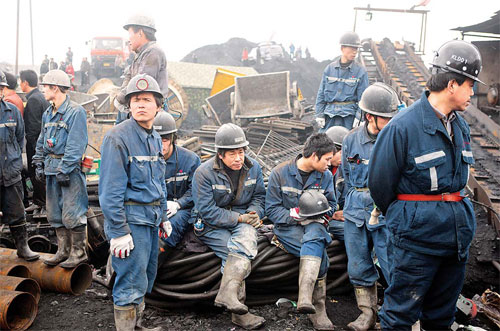Society
Another mine accident is just deja vu
By Hu Yinan (China Daily)
Updated: 2010-03-31 07:25
 |
Large Medium Small |
|
 Rescuers wait for their turn to pump out water from the Wangjialing Coal Mine. More than 150 workers were trapped when underground water fl ooded tunnels. [YANG SHIZHONG / CHINA DAILY] |
|
Disaster prompts calls to find, fill 'lost shafts' left by illegal digs Abandoned mines put lives and future construction at risk, experts tell Cao Li in Beijing As rescue teams continue to search for 153 people trapped in a mine flood in Shanxi, early investigations suggest the disaster was caused by water from an adjoining abandoned shaft. Officials say water began to gush into the State-owned Wangjialing Coal Mine after a worker carelessly ruptured a wall separating two tunnels, according to media reports on Monday. Although investigations into the disaster in Xiangning county are continuing, analysts warn that disused mine shafts, which are scattered across Central China's coal-rich provinces and contain tons of water, could prompt future disasters. Flooding is second only to gas explosions when it comes to the main causes behind pit tragedies in China, with unmapped underground shafts - most of them subjected to years of rampant, illegal digging - behind about 80 percent of mine deluges, said Zhao Tiechui, director of the State Administration of Coal Mine Safety. This month, 32 workers were killed at a mine in Luotuoshan in the Inner Mongolia autonomous region when water from connecting shafts leaked into its tunnels. "They are not just wrecking mines but also houses and land," said Li Lianji, a researcher with Shanxi Academy of Social Sciences, who has done extensive research into dangerous mine shafts. "In Qitaihe, Heilongjiang province, I saw a house sinking into the ground because of a mine shaft underneath. Its roof was almost the same level of the ground and the residents had to dig into the ground to get into their home." The mining industry has steadily grown in China over the past two decades, with about 5 billion tons of resources - gold, coal, iron ore - mined every year, said Jia Zhining, director of Shanxi No 4 Geo-engineering Investigation Institute. However, the production of every 10,000 tons of coal causes about a quarter of a hectare of land to cave in, according to Li's research. "The total land that has collapsed because of mine shafts is more than 700,000 hectares, leading to an economic loss of about 50 billion yuan ($7 billion)," he said. Analysts say what is worse is that the inappropriate or total lack of attention to abandoned pits has resulted in thousands of hazardous underground caverns. In Shanxi alone at least 5,000 square kilometers of disused shafts exist, mostly in the capital Taiyuan and Linfen, said Jia. Mining companies often do not refill pits after closing down to save money, with the job likely to increase a firm's costs by about one-third, said Li. The empty pits instead collect rain or underground water, which over time becomes acidic and contaminated with poisonous sulfureted hydrogen. Governments have realized the problems and are taking measures to relocate affected residents, but illegal mining has resulted in a large amount of unrecorded shafts. More than 13,000 illegal mines were shut down nationwide between 2005 and 2009, according to the website of the State Administration of Work Safety. Li has called for an investigation to map these "lost mines" and fill them in to prevent future disasters. If not, they could undermine construction projects and worsen the impact of an earthquake, he warned. Huang Shengchu, president of the China Coal Information Institute, agreed and urged authorities to ensure detailed investigations are carried out before any new mines are constructed. "It is too much to expect them to fill all the empty shafts but thorough investigations would avoid accidents. Underground water that is discovered can be pumped out before construction starts," he said. Developers are required by law to carry out thorough checks for water resources before beginning any project, but the rules are not well enforced, he said. "And at the moment, there are a lack of professionals in that field and companies are not rushing to train them." Most businesses are following the law, according to Zhang Yong, a spokesman for the China Coal Association. "Governments and companies are working together to relocate affected residents and to develop the land into parks or wet land. The efforts are making a difference," he said. The central government has stepped up efforts to control coal mine disasters in recent years following several major accidents. Sixteen mine floods killed 60 people in the first five months of 2009, according to the State Administration of Work Safety, which stated the main causes as irresponsible mining and a lack of prepared evacuation measures. Last September Luo Lin, director of the administration, signed stricter regulations aimed at improving the flood prevention and safety measures employed by mining companies. It was the third such set of regulation to be approved. |







